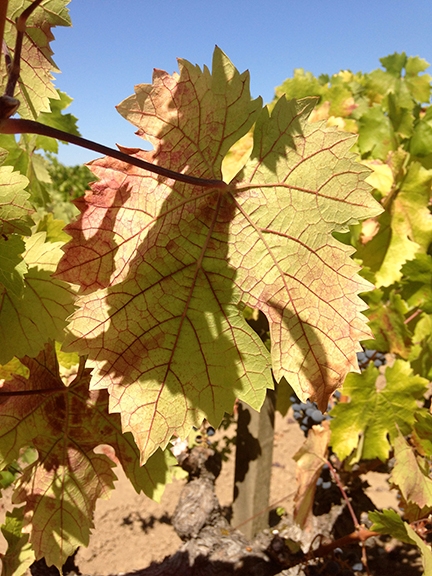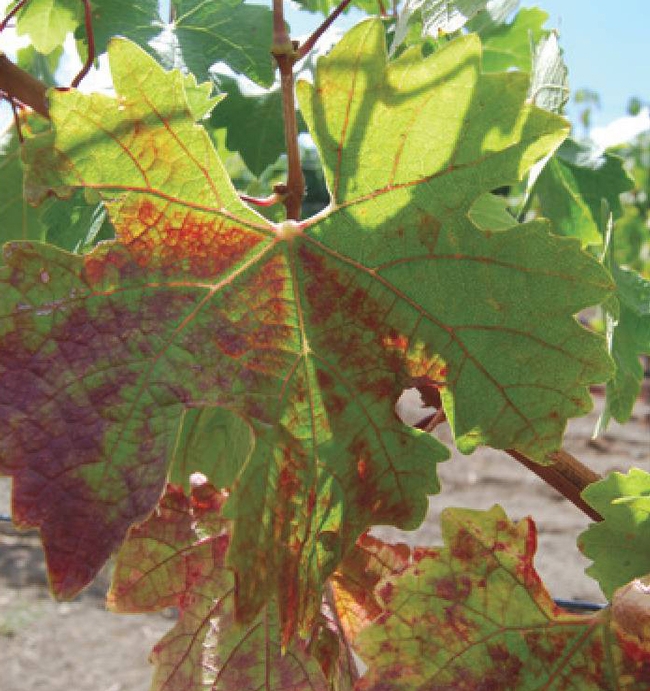- Author: Kathy Keatley Garvey

The cover features a photo of feeding injury caused by the three-cornered alfalfa hopper, Spissistilus festinus. Last year the Zalom team hypothesized that the three-cornered alfalfa hopper could transmit the Grapevine red blotch-associated virus, GRBaV, based in part on phylogeneic analysis of coat protein sequences of 23 geminiviruses that revealed that GRBaV-CP was most similar to that of another geminivirus that was transmitted by another treehopper. Their research, published in the journal, confirmed that the alfalfa hopper “was able to both acquire the virus from a grapevine infested with GRBaV and transmit the virus to healthy grapevines in the laboratory.”
“In commercial vineyards, lateral shoots of grapevines girdled due to feed injury by the adult three-cornered alfalfa hopper also tested positive for the virus using digital PCR,” the scientists noted in their abstract. “These findings represent an important step in understanding the biology of GRBaV and develop management guidelines.”
The disease, first noticed in 2008 and attributed to a newly identified virus in 2012, is present in many major grape production regions of the United States and Canada. It can reduce fruit quality and ripening.
The research team consisted of Zalom, distinguished professor, UC Davis Department of Entomology and Nematology; Sudarshana, USDA/ARS research biologist based at the UC Davis Department of Plant Pathology; Brian Bahder, then a postdoctoral researcher in the Zalom lab and now an assistant professor and insect vector ecologist with the University of Florida; and Maya Jayanth, then a student in the Sudarshana lab.
Zalom, a past president of the 7000-member Entomological Society of America, Sudarshana, and UC Cooperative Extension farm advisors Rhonda Smith and Lynn Wunderlich published a National Pest Alert on the Grapevine Red Blotch-associated virus earlier this year.
In the Pest Alert, Zalom noted that “red leaf symptoms that differed from other known red leaf diseases affecting grape foliage” were first noticed in red wine grape cultivars in Napa County, and subsequently in many other California grape growing counties as well.
“Leaf symptoms first appear approximately mid-summer; however, timing of symptom expression differs among grapevine cultivars and year,” Zalom wrote. “In red-fruited cultivars, common symptoms include red blotches originating from the leaf margin or within the leaf blade and primary and secondary veins that often turn red. In white fruit cultivars, symptoms appear as pale green to pale yellow patches.”
Zalom noted that symptoms usually start on basal leaves and progress up the shoot. In some cultivars, such as Chardonnay and Zinfandel, “marginal burning may occur similar to severe potassium deficiency. In some red-fruited cultivars such as Malbec and Mourvèdre, the entire blade may turn red by harvest.” Grapes produced on infected vines are characterizes by reduced brix and other changes that can seriously impact wine quality.
“Foliar symptoms are generally distinct from those of grapevine leafroll disease (GLD) early in the season, but leaf blade coloration may resemble those of GLD by late fall,” Zalom pointed out. “At this time, red blotch disease is not known to kill grapevines.” However, the effect of the virus infections on yield and fruit quality varies and no cure exists at this time.
For more information on the Grapevine Red Blotch-associated virus, access https://www.ncipmc.org/action/alerts/redblotch.pdf.
Related Links:
Three-cornered alfalfa hopper, Spissistilus festinus (Viticultural Information, UC Davis)
Phylogeny of Geminivirus Coat Protein Sequences and Digital PCR Aid in Identifying Spissistilus festinus as a Vector of Grapevine Red Blotch-Associated Virus. (Phytopathology journal)
See here also in PubMed U.S. National Library of Medicine, National Institutes of Health


- Author: Kathy Keatley Garvey

Integrated pest management specialist Frank Zalom, distinguished professor of entomology, UC Davis Department of Entomology and Nematology, and plant pathologist Mysore "Sudhi" Sudarshana with the U.S. Department of Agriculture's Agricultural Research Service, based at UC Davis, organized the webinar. The event is supported by the Regional IPM centers as part of the U.S. Department of Food and Agriculture's National Institute of Food and Agriculture (NIFA).
Registration is underway at https://attendee.gotowebinar.com/register/536624718414291457
GRB and the virus associated with it have been confirmed in many major grape production regions of the United States and Canada, said Zalom, the lead author of the newly published Regional Pest Alert on the North Central IPM Center website. Several research teams across North America, Zalom said, “have been intensely characterizing the disease and effects on grapevines, as well as characterizing the virus, its spread and potential management” since the discovery of the virus in 2011.
Zalom cited considerable progress, “but much remains unknown. Speakers representing many of the labs will present their work and what it means for the grape industry.”
“Red leaf symptoms that differed from other known red leaf diseases affecting grape foliage were first noticed in vineyards planted with red wine grape cultivars in Napa County, California, in 2008,” he wrote in the Regional Pest Alert. “A virus now known as Grapevine Red Blotch-associated virus (GRBaV) was subsequently identified in grapevines exhibiting red blotch symptoms in 2011. It is now confirmed that red blotch disease is present in many major grape production regions of the United States and Canada.”
The agenda:
- 10 a.m.: Welcome and Introduction
Frank Zalom, UC Davis - 10:05: History of red blotch, symptoms and significance
Mysore "Sudhi" Sudarshana, USDA's Agricultural Research Service, USDA-ARS, Davis, Calif. - 10:20: Etiology of red blotch
Marc Fuchs, Cornell University, Geneva, N.Y. - 10:35: Detection and genetic diversity of the virus
Keith Perry, Cornell University, Ithaca, N.Y. - 10:50: Effect of red blotch on grapevine performance
Rhonda Smith, UC Cooperative Extension, Sonoma County - 11:05 Red blotch situation in Oregon
Vaughn Walton, Oregon State University and Bob Martin, USDA-ARS, Corvallis, Ore. - 11:20: Red blotch and the virus in Canada
S. Poojari, T. Lowery, A-M. Schmidt, M. Rott, W. Mcfadden-Smith, L. Stobbs, and J.R. Urbez-Torres, Agri-Canada - 11:35: Red blotch and the virus in Europe
Jean-Sebastian Reynard, Agroscope, Switzerland - 11:50: Virus spread, disease gradient, and insects
Brian Bahder, Frank Zalom lab, UC Davis - 12:05: Foundation Plant Services (FPS) and National Clean Plant Network (NCPN) protecting the supply chain of grapevines from red blotch
Deborah Golino, FPS, UC Davis - 12:20: Questions and answers
Moderated by Frank Zalom
Related Links:
- Regional Pest Alert on Grapevine Red Blotch-associated virus (PDF on North Central IPM Website)
- Link to Webinar registration: https://attendee.gotowebinar.com/register/536624718414291457
- Biosketches on speakers: http://www.ipmcenters.org/index.cfm/center-products/ipm-eacademy/upcoming-events/red-blotch-speakers/




